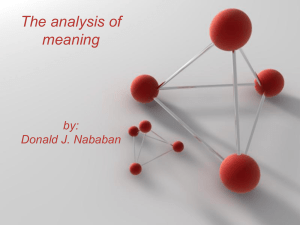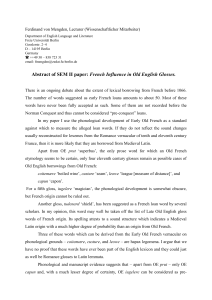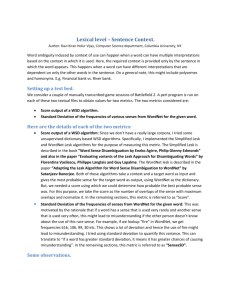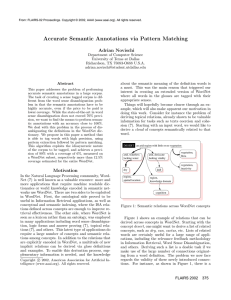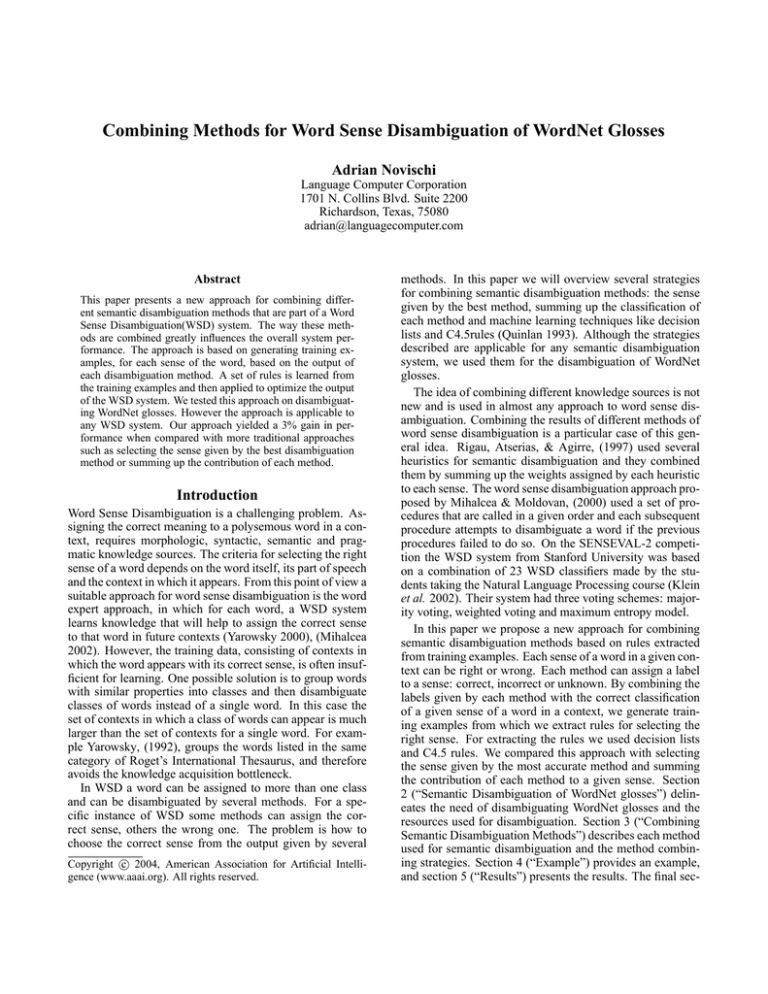
Combining Methods for Word Sense Disambiguation of WordNet Glosses
Adrian Novischi
Language Computer Corporation
1701 N. Collins Blvd. Suite 2200
Richardson, Texas, 75080
adrian@languagecomputer.com
Abstract
This paper presents a new approach for combining different semantic disambiguation methods that are part of a Word
Sense Disambiguation(WSD) system. The way these methods are combined greatly influences the overall system performance. The approach is based on generating training examples, for each sense of the word, based on the output of
each disambiguation method. A set of rules is learned from
the training examples and then applied to optimize the output
of the WSD system. We tested this approach on disambiguating WordNet glosses. However the approach is applicable to
any WSD system. Our approach yielded a 3% gain in performance when compared with more traditional approaches
such as selecting the sense given by the best disambiguation
method or summing up the contribution of each method.
Introduction
Word Sense Disambiguation is a challenging problem. Assigning the correct meaning to a polysemous word in a context, requires morphologic, syntactic, semantic and pragmatic knowledge sources. The criteria for selecting the right
sense of a word depends on the word itself, its part of speech
and the context in which it appears. From this point of view a
suitable approach for word sense disambiguation is the word
expert approach, in which for each word, a WSD system
learns knowledge that will help to assign the correct sense
to that word in future contexts (Yarowsky 2000), (Mihalcea
2002). However, the training data, consisting of contexts in
which the word appears with its correct sense, is often insufficient for learning. One possible solution is to group words
with similar properties into classes and then disambiguate
classes of words instead of a single word. In this case the
set of contexts in which a class of words can appear is much
larger than the set of contexts for a single word. For example Yarowsky, (1992), groups the words listed in the same
category of Roget’s International Thesaurus, and therefore
avoids the knowledge acquisition bottleneck.
In WSD a word can be assigned to more than one class
and can be disambiguated by several methods. For a specific instance of WSD some methods can assign the correct sense, others the wrong one. The problem is how to
choose the correct sense from the output given by several
c 2004, American Association for Artificial IntelliCopyright gence (www.aaai.org). All rights reserved.
methods. In this paper we will overview several strategies
for combining semantic disambiguation methods: the sense
given by the best method, summing up the classification of
each method and machine learning techniques like decision
lists and C4.5rules (Quinlan 1993). Although the strategies
described are applicable for any semantic disambiguation
system, we used them for the disambiguation of WordNet
glosses.
The idea of combining different knowledge sources is not
new and is used in almost any approach to word sense disambiguation. Combining the results of different methods of
word sense disambiguation is a particular case of this general idea. Rigau, Atserias, & Agirre, (1997) used several
heuristics for semantic disambiguation and they combined
them by summing up the weights assigned by each heuristic
to each sense. The word sense disambiguation approach proposed by Mihalcea & Moldovan, (2000) used a set of procedures that are called in a given order and each subsequent
procedure attempts to disambiguate a word if the previous
procedures failed to do so. On the SENSEVAL-2 competition the WSD system from Stanford University was based
on a combination of 23 WSD classifiers made by the students taking the Natural Language Processing course (Klein
et al. 2002). Their system had three voting schemes: majority voting, weighted voting and maximum entropy model.
In this paper we propose a new approach for combining
semantic disambiguation methods based on rules extracted
from training examples. Each sense of a word in a given context can be right or wrong. Each method can assign a label
to a sense: correct, incorrect or unknown. By combining the
labels given by each method with the correct classification
of a given sense of a word in a context, we generate training examples from which we extract rules for selecting the
right sense. For extracting the rules we used decision lists
and C4.5 rules. We compared this approach with selecting
the sense given by the most accurate method and summing
the contribution of each method to a given sense. Section
2 (“Semantic Disambiguation of WordNet glosses”) delineates the need of disambiguating WordNet glosses and the
resources used for disambiguation. Section 3 (“Combining
Semantic Disambiguation Methods”) describes each method
used for semantic disambiguation and the method combining strategies. Section 4 (“Example”) provides an example,
and section 5 (“Results”) presents the results. The final sec-
tion draws the conclusions and discusses further work.
Semantic Disambiguation of WordNet glosses
The semantic disambiguation of WordNet glosses is part
of eXtended WordNet project (http://xwn.hlt.utdallas.edu)
whose target is to extract new information from WordNet
glosses (Miller 1995) and to overcome the limited number
of connections between topically related words. By linking each word in a gloss to each corresponding concept, we
can increase the number of connections between topically
related concepts: by adding a link between two concepts
that appear in the same gloss or between these concepts and
the synset of the gloss.
Semantic disambiguation of WordNet glosses is different
from semantic disambiguation of open text. First, the meaning of the concept to which the gloss belongs restricts for the
possible senses of the open class words in the gloss. Second, the gloss is not a complete sentence. Several transformations have to be made in order to transform a gloss
into a sentence. Third, the glosses have an idiosyncratic nature containing patterns in which the open class words have
the same sense. Fourth, we cannot train statical methods
on a set of disambiguated glosses, since a lot of words appears few times in WordNet glosses and do not exhibit the
entire range of senses. A set of semantic disambiguation
glosses is more useful for testing than for training. For semantic disambiguation of WordNet glosses, we rely on a set
of heuristics that exploit the information contained in WordNet or are based on external resources like SemCor. SemCor
(Miller et al. 1994) is a corpus formed with about 25% of
the Brown Corpus files having all the words part of speech
tagged and semantically disambiguated. The SemCor corpus was annotated with senses from WordNet 1.6. In order
to disambiguate using WordNet 2.0 we automatically transformed the senses from WordNet 1.6 to WordNet 2.0 using
the sense keys.
Combining Semantic Disambiguation Methods
The heuristics used for semantic disambiguation of WordNet glosses were first described in (Harabagiu, Miller, &
Moldovan 1999), (Mihalcea & Moldovan 2001) and (Novischi 2002). In this paper I will provide only a short description for each method:
Same hierarchy relation - assigns to a noun or verb in a
gloss the sense that is an ancestor of the synset of the gloss.
Lexical parallelism - identifies the words with the same
part of speech separated by commas or conjunctions and
marks them with the senses that belongs to the same hierarchy (for nouns and verbs) or to the same cluster (for adjectives). In the case of nouns and verbs this method can find
multiple pair of senses belonging to different hierarchies.
SemCor previous word - given a word in a gloss this
heuristic forms a pair with the previous word in a gloss and
searches this pair in SemCor corpus. If in all occurrences of
this pair the given word has the same sense, then the heuristic assigns this sense to the target word.
SemCor next word - the same as the previous heuristic
but this heuristic forms a pair from the target word in a gloss
and the next word and searches this pair in SemCor corpus.
If the target word has the same sense in all occurrences of
the pair, then the heuristic assigns this sense to the target
word.
Cross reference - given an ambiguous word W in the
synset S, this method looks for a reference to the synset S
in all the glosses corresponding to word W’s senses. By
reference to a word W we understand a word or a part of
compound concept that has the same lemma as the word W.
Reversed cross reference - given a word W in the gloss G
of the synset S this method assigns to the word W the sense
that contains in its set of synonyms one of the words from
the gloss G.
Distance among glosses - determines the number of common word lemmas between two glosses. For an ambiguous
word W in a gloss G this method selects the sense with the
greatest number of common word lemmas with the gloss G.
Common Domain - Magnini & Cavaglia (2000) assigned
a domain label to all the noun synsets in WordNet 1.6. We
translated these domains for the noun synsets in WordNet
2.0. Using these synset labels, this method selects the sense
of a word in a gloss that has the same domain as the synset
of the gloss.
Patterns - exploits the idiosyncratic nature of the WordNet glosses. The patterns of the form “N successive words”
and “M words ... N words” are extracted offline from
the WordNet glosses and are selected and manually disambiguated. This method matches the patterns against glosses
and assign to the words the corresponding sense in the pattern.
First Sense Restricted - this method assign sense 1 to a
noun or verb if this sense has the smallest number of ancestors in the ISA hierarchy from all senses (it is the most
general sense). The method selects sense 1 for an adjective
if this sense has the greatest number of similarity pointers
than all the other senses. This methods is based on the intuition that, in WordNet glosses, most of the words are used in
their most general sense.
Combining Methods
Each of the method tags a word with a sense. Between two
methods that tag a word with different senses, we would like
to know which one is right and which one is wrong. If a
method assigns a sense to a given word we can consider that
the method assigns the tag CORRECT to that sense and INCORRECT to the other senses. If the method does not assign a sense to that word, we can consider that the method
assigns the tag UNKNOWN to all senses. The final classification of a sense of a word is CORRECT or INCORRECT.
For a disambiguated word taken from gold-standard, we
can generate a number of training examples equal to the
number of senses, each training example corresponding to
a sense. Each training example contains as attributes the
tags assigned by each method to the corresponding sense.
In the training example we also include the part of speech
of the word, e.g.: NOUN, VERB, ADJ, ADV. We can also
add as attributes the output returned by other features. For
example we can consider as a feature the fact that the given
sense corresponding to the training example is the hypernym
of the synset of the gloss. This feature can output TRUE or
FALSE. In the current implementation we do not have any
attributes other than the tags assigned by the disambiguated
methods and the part of speech tagger.
For each gloss in the gold standard file and for each open
class word in the gloss we generate a set of training examples. From all training example we extract rules using different machine learning techniques. Then, we use the learned
rules to optimize the output of a WSD system that is based
on several disambiguation methods. For each sense of a new
word, given the output of the disambiguation methods, we
select a label for that sense: CORRECT or INCORRECT.
To each sense we assign a value given by the accuracy of
the rule. We assign a positive number to a sense labeled
as CORRECT and a negative number given by the negated
accuracy value of the rule if the sense is labeled as INCORRECT. Then we select as correct the sense with the highest
score.
An advantage of this approach is the ability to incorporate
incomplete sources of information as attributes. As previously stated, we add attributes that output TRUE or FALSE.
We also have methods that say only when one sense is INCORRECT. Sometimes in a given context for a word, we
cannot easily explain why a given sense is correct, but we
can very easily explain (and implement as a computer procedure) why a sense is incorrect. Another advantage is that
this approach allows a WSD system to be easily improved.
Analyzing the output of the system one can observe the conditions when a given method mistakes the sense of a word.
Then, those conditions can be implemented as a feature in
the program, that outputs TRUE or FALSE, and the system
automatically generates a rule that states the fact that the
method gives incorrect results when the feature is TRUE.
We can generate three training examples for each sense of
the noun money. These training examples are presented in
Table 1.
Example
Results
Using as features all the methods described in the previous
section and the part of speech of the word, we attempt to disambiguate the noun money in the gloss of sense 3 of finance
in WordNet 2.0:
finance#3 – the management of money and credit and
banking and investments
The noun money has three senses:
money#1 – the most common medium of exchange; functions as legal tender; ”we tried to collect the money he owed
us”
money#2 – wealth reckoned in terms of money; ”all his
money is in real estate”
money#3 – the official currency issued by a government
or national bank; ”he changed his money into francs”
Applying the disambiguation methods described in the
previous section we achieved the following results:
The Patterns and SemCor previous methods assigned
sense 1.
The Domains method assigned sense 2.
The Gloss distance method assigned sense 3.
The Lexical parallelism method labeled all three senses
as correct.
The correct sense of the noun money, taken from goldstandard file, is sense 2.
Attribute
POS (Part of Speech)
HYPER (Same hierarchy)
PATTERNS (Patterns)
DOMAINS (Domains)
LEXPAR (Lexical par.)
S PREV (SemCor prev. word)
S NEXT (SemCor next word)
GDIST (Gloss distance)
CREF (Cross reference)
RCREF (Rev.Cross Reference)
FSENSER (First Sense Restr.)
Sense Classification
Training
example for
Sense 1
NOUN
UNKNOWN
CORRECT
INCORRECT
CORRECT
CORRECT
UNKNOWN
INCORRECT
UNKNOWN
UNKNOWN
UNKNOWN
INCORRECT
Training
example for
Sense 2
NOUN
UNKNOWN
INCORRECT
CORRECT
CORRECT
INCORRECT
UNKNOWN
INCORRECT
UNKNOWN
UNKNOWN
UNKNOWN
CORRECT
Training
example for
Sense 3
NOUN
UNKNOWN
INCORRECT
INCORRECT
CORRECT
INCORRECT
UNKNOWN
CORRECT
UNKNOWN
UNKNOWN
UNKNOWN
INCORRECT
Table 1: Training examples generated for each sense of the
noun money
We use these training examples in two ways:
STEP 1. The training examples are extracted from a disambiguated gold standard file. Therefore for each training
example we have its correct classification. We extract rules
that can be applied to new training examples that are not
classified.
STEP 2. The training examples are extracted from raw text,
therefore we do not have their correct classification. We use
the rules learned at STEP 1 to assign a label to each training
example: CORRECT or INCORRECT.
First, we measured the accuracy and recall of each method
on a set of 3196 gold standard glosses. The recall is defined
as the ratio between the number of correctly disambiguated
words and the total number of target words. The precision is
defined as the ratio between the number of correctly disambiguated words and the number of attempted words. When
we computed these ratios, we did not include the number of
monosemous words since these words do not require any effort for disambiguation. The results are presented in Table
2.
Method
Same Hierarchy
Patterns
Domains
Lexical Parallelism
SemCor previous word
SemCor next word
Gloss distance
Cross Reference
Rev. Cross Reference
First Sense Restricted
Recall
23.77%
8.31%
21.48%
12.68%
3.23%
5.28%
12.10%
4.02%
2.85%
28.68%
Precision
94.48%
82.66%
81.57%
73.07%
63.37%
62.39%
63.44%
62.35%
57.07%
58.12%
Table 2: Precision and Recall for WSD methods
Second, we combined these method using four strategies:
choosing the sense of the best method, summing the contribution of each method for each sense of the target word and
machine learning strategies based on rules extracted using
C4.5 and decision lists (Yarowsky 2000).
The first strategy used is obvious: for a word that is tagged
with senses by several methods, we choose the sense given
by the most accurate method.
The second strategy sums all the contributions of the disambiguation methods for each sense of the word, and selects
the sense with the greatest value. We define the contribution
of each method to be its accuracy. This is a simple version
of the strategy used by Rigau, Atserias, & Agirre (1997) for
their system and represents the second approach for combining the classifiers that formed the Stanford WSD system in
SENSEVAL-2 competition.
The machine learning strategies consist in C4.5 rules and
decision lists. We considered decision lists of size 1, 2, 3
and 4. For the size 1 decision list we considered as a feature an attribute from generated training examples and for
each feature fi we computed a smoothed log-likelihood ra|s)
tion PP(f(fii|¬s)
(Yarowsky 2000), where s means that the current sense is CORRECT and ¬s means that the current sense
is incorrect. We sorted all the features in decreasing order of
this ratio and build a decision list.
For decision lists of size 2 we considered as a feature two
attributes from generated training examples. For all possible
features we computed the same smoothed log-likelihood ratio and built a decision list with the set of features sorted in
decreasing order of the ratio value. In the same way we built
decision lists for sizes 3 and 4 using as features a combination of 3, respectively 4 attributes.
After generating the rules, for each training example corresponding to a sense of the target word, we applied the
rules to tag that sense as correct or incorrect. We assigned
a weight to each sense of the target word as being the right
sense. This weight is the rule accuracy if the first matched
rule labels the sense as correct or negated accuracy if the rule
labels the sense as incorrect. Then the final sense selected is
the sense with the greatest weight.
For testing the first two strategies we used the whole goldstandard file of 3196 noun glosses. For testing machine
learning strategies we performed a 10-fold cross validation.
The results are presented in Table 3. As we can see from
the table, the approach of using C4.5 rules and decision lists
achieve 2-3% gain in accuracy over selecting the sense given
by the best method.
Voting scheme
Best method
Summing
C4.5 rules
Decision List 1
Decision List 2
Decision List 3
Decision List 4
Recall
65.94%
65.18%
62.81%
68.27%
68.07%
68.27%
68.37%
Precision
76.04%
75.17%
78.27%
79.04%
78.90%
79.04%
79.35%
Table 3: Precision for different voting schemes
Conclusion and further work
A word in a given context can be disambiguated by several
methods. Each method can be right or wrong. The performance of a WSD system depends on the approach of combining the results from several methods. We presented in this
paper a combination approach based on generating training
examples for each sense of a word, each training example
containing the output of each disambiguating method and its
part of speech. Then we extracted rules from these training
examples using C4.5 and decision lists and used these rules
for combining the method for selecting the correct sense. We
tested this approach for semantic disambiguation of WordNet glosses. The system gained 3% in precision when compared against the approach that select the sense given by the
best method. This approach has the advantage that it can
incorporate others sources of information including methods that only say if a given sense of a word in a context is
wrong. We can further investigate other learning mechanism
from the generated training examples or insert new features
in the training example for increasing the accuracy.
References
Harabagiu, S.; Miller, G.; and Moldovan, D. 1999. WordNet 2 - a morphologically and semantically enhanced resource. In Proceedings of SIGLEX-99, 1–8.
Klein, D.; Toutanova, K.; Ilhan, H. T.; Kamvar, S. D.; and
Manning, C. D. 2002. Combining heterogeneous classifiers for word sense disambiguation. In Proceedings of
the SIGLEX/SENSEVAL Workshop on Word Sense Disambiguation: Recent Successes and Future Directions, 74–
80. Philadelphia: Association for Computational Linguistics.
Magnini, B., and Cavaglia, G. 2000. Integrating subject
field codes into WordNet. In Proceedings of the LREC2000.
Mihalcea, R., and Moldovan, D. 2000. An iterative approach to word sense disambiguation. In Proceedings of
FLAIRS-2000, 219–223.
Mihalcea, R., and Moldovan, D. 2001. eXtended WordNet:
progress report. In Proceedings of NAACL Workshop on
WordNet and Other Lexical Resources, 95–100.
Mihalcea, R. 2002. Instance based learning with automatic
feature selection applied to word sense disambiguation. In
Proceedings of the 19th International Conference on Computational Linguistics COLING 2002.
Miller, G.and Chodorow, M.; Landes, S.; Leacock, C.; and
Thomas, R. 1994. Using a semantic concordance for sense
identication. In Proceedings of the ARPA Human Language
Technology Workshop, 240–243.
Miller, G. 1995. Wordnet: a lexical database. Communications of the ACM 38(11):39–41.
Novischi, A. 2002. Accurate semantic annotations via pattern matching. In Proceedings of Florida Artificial Intelligence Research Society, 375–379.
Quinlan, J. 1993. C4.5: Programs for Machine Learning.
Morgan Kaufmann.
Rigau, G.; Atserias, J.; and Agirre, E. 1997. Combining
unsupervised lexical knowledge methods for word sense
disambiguation. In Cohen, P. R., and Wahlster, W., eds.,
Proceedings of the Thirty-Fifth Annual Meeting of the Association for Computational Linguistics and Eighth Conference of the European Chapter of the Association for
Computational Linguistics, 48–55. Somerset, New Jersey:
Association for Computational Linguistics.
Yarowsky, D. 1992. Word-sense disambiguation using statistical models of roget’s categories trained on large corpora. In Proceedings, COLING-92, 454–460.
Yarowsky, D. 2000. Hierarchical decision lists for word
sense disambiguation. Computer and the Humanities
34(1/2).



